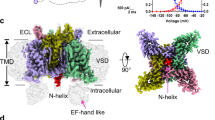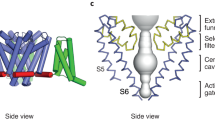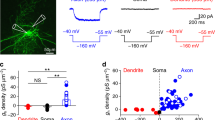Abstract
Following some preliminary reports1,2, mammalian fibres from rabbit3 and rat4,5 have recently been successfully studied in detail by means of the voltage clamp. The early transient or sodium conductance system was found to be similar to that in frog and squid axons. However, the delayed conductance or potassium currents were found to be negligible4,6. Only after chemical and osmotic manipulations, which were said to expose channels buried under the myelut, did Chiu and Ritchie7 find delayed currents in rabbit fibres. If confirmed, this would mean that the membrane conductance system of mammalian fibres is so different from that of invertebrate and amphibian axon models as to make the data base gathered from amphibian myelinated fibres (frog and toad) and invertebrate giant axons (squid and myxicola) irrelevant to human and other mammalian fibres. However, we show here that it is possible to find in the normal nodal membrane of rat myelinated fibres potassium currents that flow through channels which are similar in many respects to those found in the frog node or squid axons.
This is a preview of subscription content, access via your institution
Access options
Subscribe to this journal
Receive 51 print issues and online access
$199.00 per year
only $3.90 per issue
Buy this article
- Purchase on Springer Link
- Instant access to full article PDF
Prices may be subject to local taxes which are calculated during checkout
Similar content being viewed by others
References
Horackova, M., Nonner, W. & Staempfli, R. Proc. int. Un. physiol. Sci. 7, 198 (1968).
Nonner, W. & Staemfli, R. in Laboratory Techniques in Membrane Biophysics (eds Passow, H. & Staempfli, R.) 171–175 (Springer, Berlin, 1969).
Chiu, S. Y., Mrose, H. E. & Ritchie, J. M. Nature 279, 327–328 (1979).
Brismar, T. J. Physiol., Lond. 298, 171–184 (1980).
Palti, Y. & Binah, O. Biophys. Soc. Abstr. 2074 (1980).
Chiu, S. Y., Ritchie, J. M., Rogart, R. B. & Stagg, D. J. Physiol., Lond. 292, 149–166 (1979).
Chiu, S. Y. & Ritchie, J. M. Nature 284, 170–171 (1980).
Nonner, W. Pflügers Arch. ges. Physiol. 309, 116–192 (1969).
Palti, Y., Moran, N. & Staempfli, R. Biophys. J. (in the press).
Palti, Y., Gold, R. & Staempfli, R. Biophys. J. 25, 17–31 (1979).
Århem, P., Frankenhaeuser, B. & Moore, L. E. Acta physiol. scand. 88, 454–466 (1973).
Palti, Y. & Adelman, W. J. J. Membrane Biol. 1, 431–458 (1969).
Hodgkin, A. L. The Conduction of the Nervous Impulse (Springfield, Illinois, 1964).
Hille, B. in Biophysics and Physiology of Excitable Membranes (ed. Adelman, W. J.) 230–246 (Van Nostrand, New York, 1980).
Author information
Authors and Affiliations
Rights and permissions
About this article
Cite this article
Binah, O., Palti, Y. Potassium channels in the nodal membrane of rat myelinated fibres. Nature 290, 598–600 (1981). https://doi.org/10.1038/290598a0
Received:
Accepted:
Issue Date:
DOI: https://doi.org/10.1038/290598a0
This article is cited by
-
Developmental changes at the node and paranode in human sural nerves: morphometric and fine-structural evaluation
Cell & Tissue Research (1993)
-
Electron microscopic serial section analysis of nodes of Ranvier in lumbosacral spinal roots of the cat: ultrastructural organization of nodal compartments in fibres of different sizes
Journal of Neurocytology (1983)
-
Potassium permeability in thin amphibian myelinated fibres
Pfl�gers Archiv European Journal of Physiology (1982)
-
Clustering of ion channels at the node of Ranvier
Nature (1981)
Comments
By submitting a comment you agree to abide by our Terms and Community Guidelines. If you find something abusive or that does not comply with our terms or guidelines please flag it as inappropriate.



